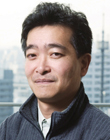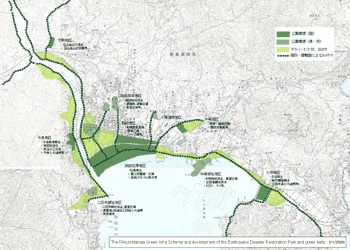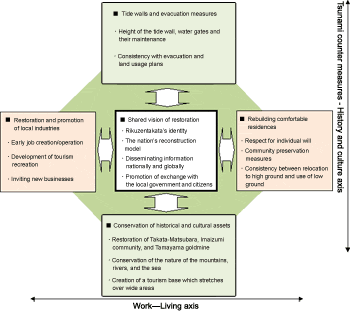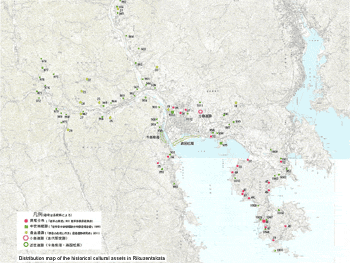Top>Opinion>Supporting Homeland Restoration Activities in Rikuzentakata: Looking Toward the Coming Millennium (Part 2)
 Index
Index

Masayoshi Tanishita [Profile]
Supporting Homeland Restoration Activities in Rikuzentakata:
Looking Toward the Coming Millennium (Part 2)
Masayoshi Tanishita
Professor, Faculty of Science and Engineering, Chuo University
Areas of specialization: Urban Engineering, Quantitative Spatial Analysis
(Part 1)
1. Introduction
2. Now, in the tsunami-stricken area
3. Government activities
4. Utilizing Rikuzentakata's History and Culture
When I visited Rikuzentakata at the end of last year, I was asked to "provide an opportunity to hear the voices of citizens who had not said what they wanted to say." Responding to the request, the Rikuzentakata no Mirai o Kataro Kai [Meeting for talking about the future of Rikuzentakata] was held twice in January this year, while young people from Rikuzentakata also organized the Takata no Koto Katappe Kai![]() [Meeting for talking over Rikuzentakata].
[Meeting for talking over Rikuzentakata].
At the meetings, participants expressed their concerns on the restoration of work and the living environment as well as tsunami disaster prevention, and made an appeal to "value the history and culture of Rikuzentakata." (Figure 1)
I recognized that in Rikuzentakata, distinctive historical culture had been handed down continuously in each town, from ancient times through the medieval and early modern periods to the present, and that there were many historical and cultural assets can proudly be offered to the world.
- ・
- The Koizumi ruins (Takata), where local government office of Kesen county are said to have existed, and Futsukaichi (Osabe), Hachiman (Takata), and Yonegasaki (Yonesaki) castles of the medieval period are suitable places to think of a disaster prevention system 1,000 years in advance.
- ・
- The Tamayama (Takekoma) and Shigekura (Yonesaki) gold mines have historical linkages to Todai-ji temple, Yu wang shan (China), Hiraizumi, as well as Imaizumi and Takata-Matsubara.
- ・
- Hirota and Otomo are suitable places to learn about the lives of people who have been living with the sea and tsunami since the Jomon period.
- ・
- Hikamisan is a landmark mountain, which is beautiful when viewed from the sea, and which also has rare plants including Benthamidia japonica f. rosea.
- ・
- The Kesen River has brought various blessings to the Hirota Bay not limited to alluvial gold.
- ・
- Yahagi and Yokota, being out of reach of tsunami, have been important trading posts with the Kesen River and routes to inland areas. These towns also have a long history of fighting floods.
- ・
- In the Edo period, Imaizumi-shuku (Okimoiri or great village headman, musket troops, etc.), Takata-Matsubara, and Imaizumi-Matsubara were created. Seventy-percent of the Okimoiri residence survived the tsunami, and the miracle pine tree became a symbol of reconstruction efforts.
- ・
- In the course of its history, Rikuzentakata experienced several massive tsunami, such as those caused by the Jogan (869) and Keicho (1611) earthquakes.
Dr. Minami Hirakawa, Director-General of the National Museum of Japanese History, says that "Rikuzentakata, as the center of Kesen county, had remained a key hub to northern societies from ancient times through the medieval period." Also, Ms. Emiko Hatakeyama (Meiji University/Hosei University), who is originally from Rikuzentakata, explains that, "Kesen county was historically an asylum, from ancient times through the early modern period. In ancient times, at this forefront of the ritsuryo system, state-of-the-art skills had been mobilized, systems had been tried, and human resources had been appointed." "Rikuzentakata is also a reservoir of folkloric materials. Many folklorists such as Kunio Yanagita conducted field work." "Folkways are the life of the people living in the land, and therefore should be treasured as much as historical sites. Two distinct cultures form the base layers of Rikuzentakata's history and culture: One is the culture of the mountain folk, who have been involved in the production of gold, steel, lacquer, silk and charcoal, and the other is the culture of the sea folk, who have been living with the sea. They both lived on trade, riding horses in mountainous area and using boats on rivers and the sea. The land, with its abundant nature such as mineral and fisheries resources, had sustained the economy up to the mid-70's."
Furthermore, Masaru Kumagai, curator of Rikuzentaka city, stated that "even if orderly streets are restored, it is not a real restoration if we cannot preserve cultural assets, because they are the accumulation of the nature, culture, history, and memories of the land, and, therefore, the identity of Rikuzentakata." (Asahi Shimbun, August 4, 2011)
Based on these insights, we are currently proposing to improve such historical cultural assets as hubs to connect the sea, rivers, and mountains (green matrix), and through which to think of the strategies that will contribute to disaster prevention, environmental conservation, tourism, and green business. (Figure 3)

Figure 3: The Rikuzentakata Green-Infra Scheme and development of the Earthquake Disaster Restoration Park and green belts
(Click to enlarge)
5. Conclusion
Recently, I learned a Sanriku dialect word Girisube (Girisubi), which means to return favor. My support activity started with the words, "Professor, I need your counsel, not your goods." There is no more annoying thing than volunteers of goodwill who lack imagination or a keen sense of pain and mourning. In conducting support activities, I am trying to place local people's feelings at the center, always admonishing myself in order to ensure that our efforts never become such an annoyance.
Now the affected area has moved to a new phase: commercialization. The current population of Rikuzentakata is about 20,000, a 17% decrease since the disaster, and 4,000 fewer than that in 1889. Even if the infrastructure is fully developed, it will be meaningless without the people who live in the area. To ensure that this does not happen, I would like to review and propose possible mechanisms that transcend existing systems and frameworks such as parks, greenbelts, farmlands, and urban institutions, in which local people themselves can continuously manage these local resources of more than one thousand years of historical culture.
Dr. Hirakawa suggested the possibility that Kesen county was established as early as 715. If so, the year 2015 will be its 1,300th anniversary. On May 26, volunteer citizens of Rikuzentakata will invite Dr. Minami Hirakawa, Director-General of the National Museum of Japanese History, and Mitsunori Yagi, of the Miyako City Board of Education, to hold the "Symposium for Discussion on the Historical Culture of Kesen and Rikuzentakata." I hope that the reconstruction plan of Rikuzentakata will create a sense of pride within the heart of its people.
Acknowledgement: In preparing this article, I received insights from the following individuals, to whom I express my sense of gratitude: A large number of people in Rikuzentakata; Ms. Emiko Hatakeyama (Meiji University/Hosei University); Mr. Tsujino Goromaru (Shukeisha) and other members of the Green Infrastructure Study Association; Professor Toshiya Yamamoto (Meiji University), Professor Takashi Miyashiro (Hosei University), Mr. Hidemi Kamiya (Manu Institute for Urban Design and Architecture) and other members of the Support Team of Four Universities; and the members of the logistics support organization FLAT.
References and URLs
- Tanishita, Masayoshi. 2011. "The Great East Japan Earthquake: Rikuzentakata Restoration of the City and Support for It"
- Tanishita, Masayoshi. 2011. "Rikuzentakata-From Disaster Reconstruction to the Homeland Restoration" [Rikuzentakata-shinsai hukko kara furusato saisei e], Chuo Hyoron 278, pp. 61-68.
- Kono, Michihiro. March 2012. "Creating 'Rikuzentakata, a Town for Entrepreneurs'"[Kigyo no machi Rikuzentakata o tsukuru], Shincho 45, pp. 20-23.
- Kokusho, Takaji. "On Correlation between Disappearance of Pine Woods and liquefaction Caused by Tsunami" [Rikuzentakata deno tsunami ni yoru matsubara shoshitsu to ekijoka no kanren ni tsuite].

- Materials of the Green Infrastructure Study Association are available here.

- Masayoshi Tanishita
Professor, Faculty of Science and Engineering, Chuo University
Areas of specialization: Urban Engineering, Quantitative Spatial Analysis - Professor Tanishita was born in Ishikawa Prefecture in 1967.
He withdrew from the Doctoral Course, School of Engineering, the University of Tokyo, in 1992.
He became a Professor in 2008, on the Faculty of Science and Engineering, Chuo University, after assuming the positions of Associate Researcher at the University of Tokyo, Full-Time Lecturer in School of Engineering, at the University of Tokyo, Full-Time Lecturer, Assistant Professor and Associate Professor on the Faculty of Science and Engineering, Chuo University.
Area of specialization: Urban Engineering, Quantitative Spatial Analysis
Current areas of research: the external costs of automobiles and related tax systems, effects of regional planning and building agreement on the real estate market, physiological evaluation of walking space, management organization of public space, and the like.
- Research Activities as a Member of Research Fellowship for Young Scientists (DC1), Japan Society for the Promotion of Science (JSPS) Shuma Tsurumi
- Important Factors for Innovation in Payment Services Nobuhiko Sugiura
- Beyond the Concepts of Fellow Citizens and Foreigners— To Achieve SDGs Goal 10 “Reduce Inequality Within and Among Countries” Rika Lee
- Diary of Struggles in Cambodia Fumie Fukuoka
- How Can We Measure Learning Ability?
—Analysis of a Competency Self-Assessment Questionnaire— Yu Saito / Yoko Neha - The Making of the Movie Kirakira Megane










